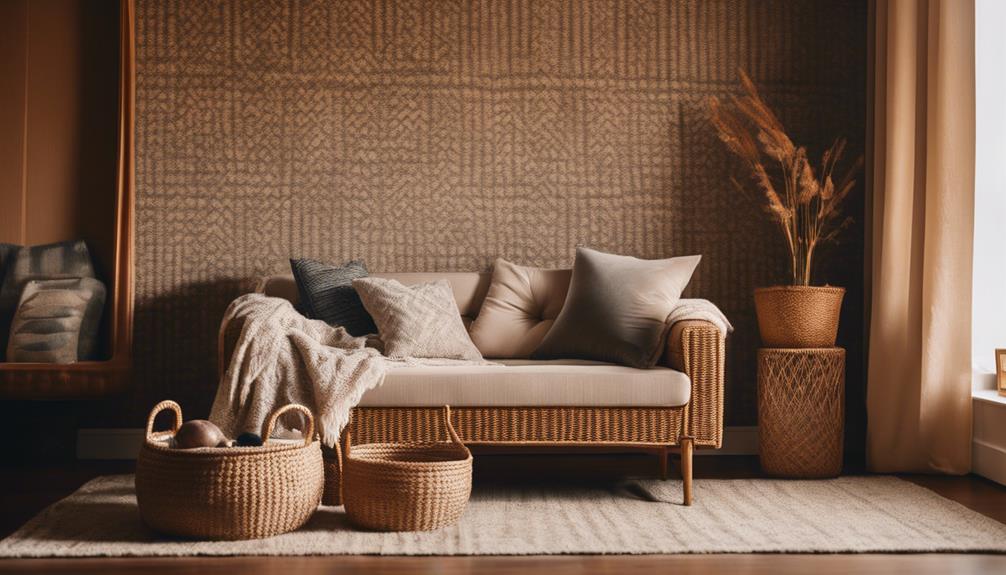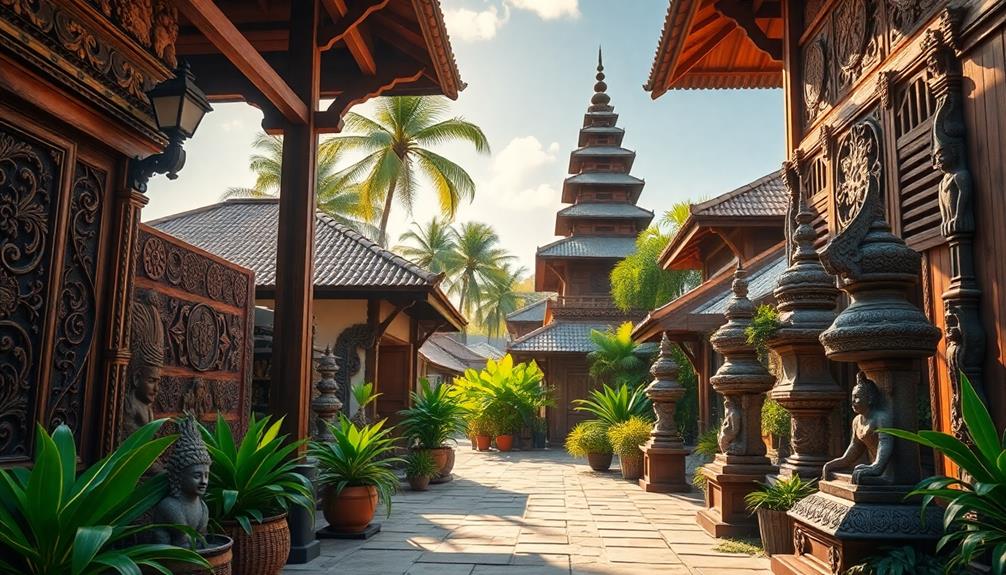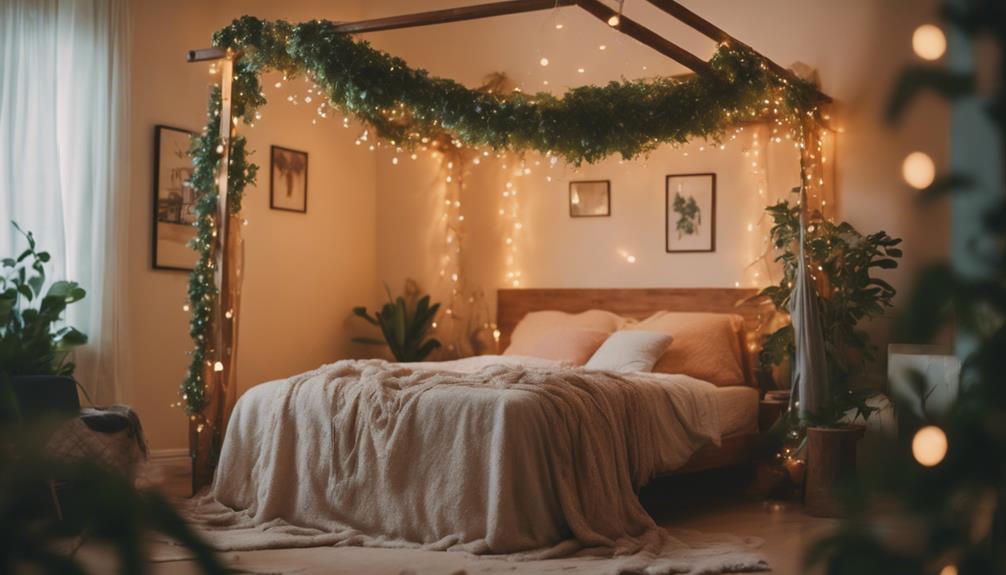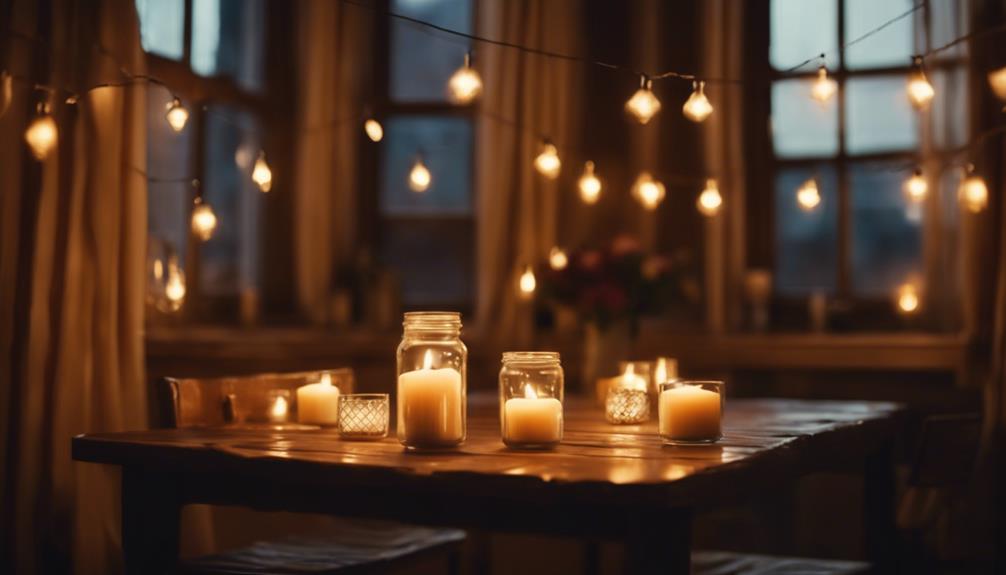Incorporating antiques into your country decor adds character and warmth. Think about using a vintage farmhouse dining table as a centerpiece that invites gatherings. Mix dark antique woods with lighter, modern colors for a balanced look. Antique lighting, like a brass chandelier or rustic lanterns, creates a cozy atmosphere. Don't forget decorative accents, like vintage porcelain figurines or lace table runners, that elevate your space. Even your flooring can shine with reclaimed barn wood or antique tiled mosaics. With these tips, you can transform your home in ways you might not have considered before. Explore further for more insights!
Key Elements

When choosing antiques for your country decor, consider the color scheme, materials, and textures that will tie everything together.
You want to create a cohesive look that feels inviting and warm.
Color Scheme
How can you effectively blend antique pieces with modern country decor through color schemes?
Start by choosing a color palette that strikes a balance between traditional and contemporary. Pair darker woods from your antique furniture with lighter, modern hues to soften the overall aesthetic. Warm colors like blues, pinks, and sage greens can beautifully complement the brown tones of your antique pieces, adding warmth without the heaviness of classic dark colors.
Consider a neutral color palette featuring washed linens and whites as a serene backdrop. This allows your antique items to stand out, turning them into focal points in the room. Layer your antique furniture with contemporary textiles and cleaner lines to create a cohesive look that harmonizes the old and the new.
Don't forget to incorporate subtle color accents that echo the tones found in your antique pieces. This promotes a cohesive and inviting atmosphere throughout your home, making your decor feel thoughtfully curated.
Materials
Blending antique materials with modern elements enriches your country decor, adding depth and character to your space. Incorporating vintage pieces like linens and floral china enhances the overall aesthetic, creating a soft, inviting feel that draws people in. Key elements such as cast iron urns and dough bowls not only represent rustic charm but also provide functional storage and decorative appeal.
Don't underestimate the power of mirrors with ornate frames; they create visual interest and depth, reflecting the traditional craftsmanship often found in country decor. Vintage silver items like candlesticks and serving trays can add an elegant touch while serving practical purposes during gatherings, making them both beautiful and functional.
Mixing various wood tones is essential for a balanced look. Pair darker antique pieces with lighter modern accents to embody the essence of country style. By thoughtfully selecting these materials, you can easily incorporate old things into your decor, ensuring that each element contributes to a cohesive and inviting atmosphere.
Textures
Mixing different textures in your country decor invites warmth and visual interest, making your space feel both cozy and unique. Start by incorporating antique furniture that showcases unique textures, like distressed wood finishes or intricate carvings. These elements add character and authenticity to your decor, setting a charming tone.
Next, layer in soft vintage linens, such as quilts and lace, to enhance the warmth of your space. The contrast between the roughness of antique furniture and the softness of textiles creates visual depth. Don't forget to include rustic wood pieces, like a wooden dough bowl, and pair them with delicate crystal accents. This combination gives your decor a dynamic look.
Emphasizing natural textures is key too. Use plants and earthy materials to soften the appearance of vintage items, achieving a harmonious balance.
Essential Fixtures and Furniture
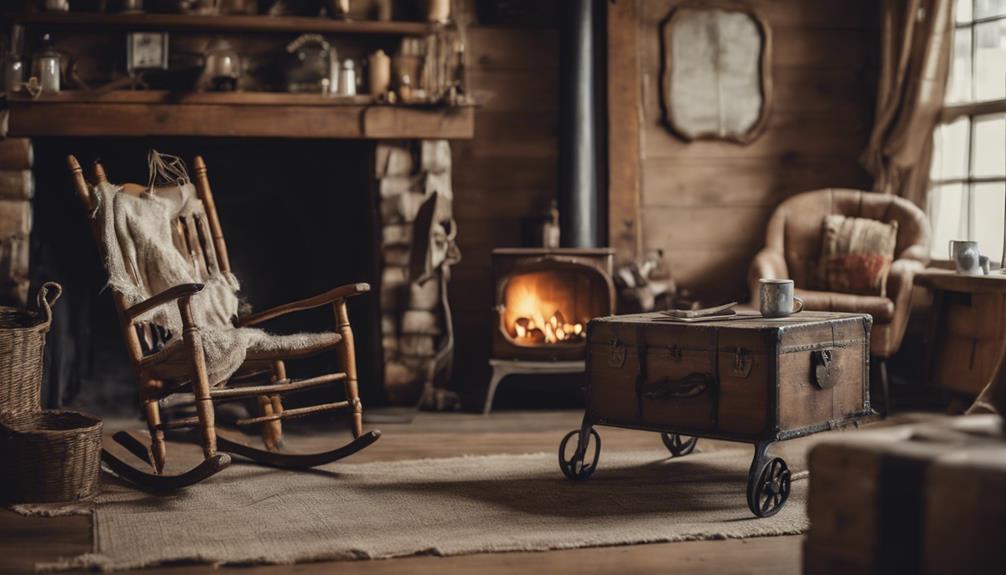
When it comes to essential fixtures and furniture in country decor, you'll want to focus on pieces that bring both function and charm.
A vintage farmhouse dining table can serve as the heart of your home, while a vintage wooden rocking chair adds a cozy touch.
Don't forget about vintage iron candle holders, which offer both ambiance and a rustic aesthetic.
Vintage Farmhouse Dining Table
A vintage farmhouse dining table often becomes the heart of your country decor, inviting family and friends to gather around its rustic charm and warm wood tones. These tables are typically made from reclaimed wood, adding unique character while promoting sustainable living practices. You'll appreciate how the sturdy construction and simple, functional design create an inviting atmosphere for gatherings.
When you choose a vintage farmhouse dining table, look for variations like trestle bases or turned legs, which reflect traditional craftsmanship and enhance the table's visual appeal. These pieces often carry stories from past generations, fostering a sense of nostalgia that enriches your decor.
To truly make your dining table stand out, consider pairing it with mismatched chairs or vintage linens. This eclectic yet cohesive look emphasizes comfort and individuality, making your dining area feel warm and welcoming.
When you shop for antiques, take your time to find the perfect dining table that not only fits your space but also resonates with your style. Ultimately, a vintage farmhouse dining table can transform your home, creating a cherished gathering spot for years to come.
Vintage Wooden Rocking Chair
Adding a vintage wooden rocking chair to your space complements the rustic charm of a farmhouse dining table while providing a cozy spot for relaxation and reflection. These timeless pieces, often crafted from durable hardwoods like oak or maple, not only enhance your decor but also showcase unique grain patterns that highlight their beauty.
Incorporating a vintage wooden rocking chair can transform a corner of your home into a welcoming reading nook or a tranquil place to unwind. Many of these chairs boast intricate details, such as hand-carved designs and original finishes, making them perfect conversation starters. They embody the essence of country living, inviting you to sit back and enjoy a moment of peace.
To find the perfect vintage wooden rocking chair, visit your local antique shop, where you can discover unique pieces that tell a story. Estate sales and online marketplaces are also great places to search for these charming chairs.
Vintage Iron Candle Holder
Embracing vintage iron candle holders instantly elevates your country decor, infusing your space with rustic charm and character. These essential fixtures not only serve a functional purpose but also enhance your home's aesthetic with their intricate designs.
You'll find that vintage iron candle holders are typically durable and long-lasting, crafted from high-quality materials that withstand the test of time.
Adding these candle holders creates an inviting ambiance, dispersing soft, warm light that's perfect for cozy gatherings. Whether you choose wall sconces, table centerpieces, or floor stands, the versatility of vintage iron candle holders allows you to incorporate them seamlessly into your space.
To achieve a harmonious balance in your decor, consider pairing these candle holders with natural elements like wood and greenery. This combination accentuates the rustic charm while making your home feel warm and welcoming.
Lighting Ideas
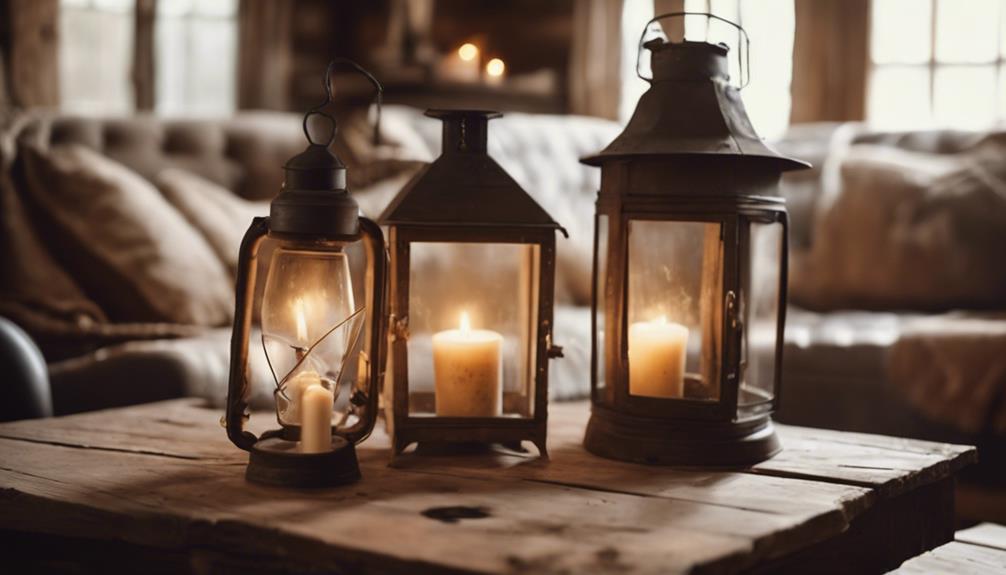
When it comes to lighting in your country decor, antique pieces can make a big impact.
Think about incorporating an antique brass chandelier as a stunning centerpiece, or using vintage lanterns for warm ambient lighting.
You can also enhance the space with rustic string lights and vintage wall sconces to create a cozy, inviting atmosphere.
Antique Brass Chandelier Centerpiece
An antique brass chandelier instantly transforms a room into a fascinating centerpiece, blending elegance with rustic charm that enhances your country decor. These stunning fixtures often feature intricate detailing and craftsmanship, making them unique statement pieces. When you choose an antique brass chandelier, consider its size and scale to guarantee it complements the dimensions of your space without overwhelming it.
The soft, warm lighting provided by an antique brass chandelier creates a cozy atmosphere, perfect for inviting friends and family over for gatherings. You can maintain that inviting ambiance while incorporating modern light bulbs for energy efficiency, allowing for a seamless blend of old and new design elements.
To truly showcase your antique brass chandelier, hang it above a dining table or in a foyer, where it can be admired by all. Pair it with other rustic elements—like wooden beams or vintage-inspired decor—to enhance its charm. By integrating this elegant lighting piece into your country decor, you not only elevate the aesthetics of your home but also embrace the warmth and history that antiques bring to your living space.
Vintage Lanterns for Ambient Lighting
Vintage lanterns add a charming, rustic touch to your country decor, providing unique ambient lighting that enhances any space. These versatile lighting options come in various styles, including oil, gas, and electric, allowing you to choose the best fit for your home, whether indoors or outdoors. When you place vintage lanterns strategically around your space, they can create a warm and inviting atmosphere, perfect for gatherings or cozy evenings at home.
Consider using vintage lanterns as centerpieces on your dining table or as accent pieces on mantels. They effortlessly blend with other antique decor elements, adding character and depth to your design. The intricate designs and materials, like wrought iron and glass, further enhance their aesthetic appeal.
To find vintage lanterns, explore flea markets, estate sales, or online marketplaces. You'll discover affordable and distinctive pieces that reflect your personal style and history. Incorporating these vintage lanterns into your decor not only elevates the ambiance but also tells a story, making your country home feel even more special.
Rustic String Lights Accents
Adding rustic string lights to your country decor not only enhances the warm ambiance but also beautifully complements the charm of vintage lanterns. These lights create a cozy atmosphere, making your space feel inviting and lived-in. You can drape rustic string lights over mantels or wrap them around tree branches, adding character to both indoor and outdoor spaces.
Consider using vintage-style string lights, especially those with Edison bulbs, to introduce a nostalgic touch that pairs perfectly with your antique furnishings. The warm white tones of LED string lights maintain the cozy feel of traditional incandescent lights while being energy-efficient and long-lasting.
To create charming focal points, think about pairing string lights with elements like vintage jars or wooden crates. This combination not only enhances the overall rustic theme but also showcases the beauty of your antique treasures.
Don't hesitate to experiment with different placements, whether hanging from beams or entwined within your decor. By incorporating rustic string lights, you elevate your country decor, making it both functional and visually appealing. Embrace this lighting idea to achieve that perfect blend of warmth and style.
Vintage Wall Sconces for Illumination
Wall sconces bring a unique blend of elegance and functionality to your country decor, enhancing both illumination and style. Vintage wall sconces are perfect for adding charm, available in various styles from rustic to ornate, allowing you to personalize your space.
Positioning sconces flanking mirrors or artwork not only improves illumination but also creates a visually appealing symmetry that draws the eye.
When choosing vintage wall sconces, consider the material and finish to guarantee they harmonize with your existing decor. You might opt for electric sconces for consistent lighting or candelabra styles for a warm, inviting glow.
Crystal accents on some sconces can add a touch of sparkle and glamour, perfectly complementing your country aesthetic while enhancing the overall ambiance.
With these versatile lighting options, you can adapt the mood for different occasions, whether you're hosting guests or enjoying a quiet evening at home.
Decorative Elements
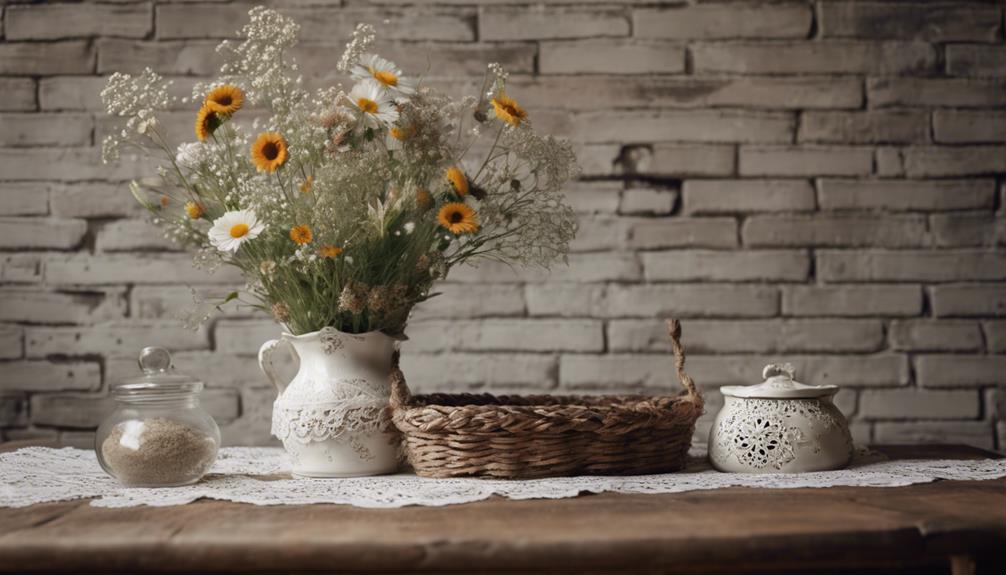
When you incorporate decorative elements like vintage porcelain figurines and lace table runners, you add a touch of history and elegance to your country decor.
Vintage floral wall art can also bring life to your walls, enhancing the overall charm of your space.
Vintage Porcelain Figurine Display
Vintage porcelain figurines can transform a country decor space into a charming display, showcasing intricate craftsmanship and elegance. These delightful pieces serve as focal points, reflecting historical artistry from eras like the Victorian or Art Nouveau periods. By collecting and displaying figurines, you not only enhance the aesthetic but also weave a rich narrative into your decor.
To make the most of your vintage porcelain figurines, consider using antique shelves or glass cabinets for their display. This not only offers protection but also allows for creative arrangements that highlight each piece's unique beauty. Opt for figurines with floral themes or nature-inspired designs to harmonize with the overall country aesthetic, creating a welcoming atmosphere.
Mixing these figurines with other antique elements, such as rustic wooden furniture or vintage textiles, adds depth and interest to your space. You'll find that layering different textures and styles brings a cohesive feel to your decor. With a little creativity, you can curate a stunning display that captures the charm of country living while showcasing your love for vintage porcelain figurines.
Vintage Lace Table Runner
A delicate lace table runner instantly elevates your country decor, adding timeless charm and intricate texture to any dining setting. You'll find that a vintage lace runner beautifully contrasts with the rustic appeal of a wooden dining room table, softening the overall look while creating a warm, inviting atmosphere. Each piece often showcases unique, handcrafted details, making it a one-of-a-kind addition that reflects personal history and craftsmanship.
These vintage lace runners are incredibly versatile. Whether you're hosting a casual family meal or an elegant dinner party, they seamlessly enhance the dining experience, turning an ordinary gathering into something special. You can layer them with additional textiles or use them alone as a focal point, depending on your style preferences.
To guarantee your vintage lace runner remains a cherished decorative element for years to come, remember to care for it properly. Gentle hand washing and air drying will help preserve its integrity, allowing you to enjoy its beauty while maintaining its delicate charm.
Vintage Floral Wall Art
Incorporating vintage floral wall art into your country decor adds a stunning focal point that brings a touch of nostalgia and natural beauty to your space. Look for pieces that feature intricate floral patterns or soft color palettes, like pastels or muted tones, which resonate perfectly with the rustic charm of country homes.
A good place to start your search is local antique shops, flea markets, or online marketplaces like Etsy. These venues often offer unique finds that not only elevate your decor but also tell a personal story.
Once you've selected your vintage floral wall art, think about how to display it. Pairing your artwork with other antique decor items, such as wooden frames or aged mirrors, creates a cohesive design that enhances the overall ambiance.
Additionally, layering your vintage floral art with textured textiles like lace or burlap can add depth and visual interest to your walls. This combination makes your country decor feel even warmer and inviting, allowing you to showcase your style while celebrating the beauty of nature through art.
Flooring
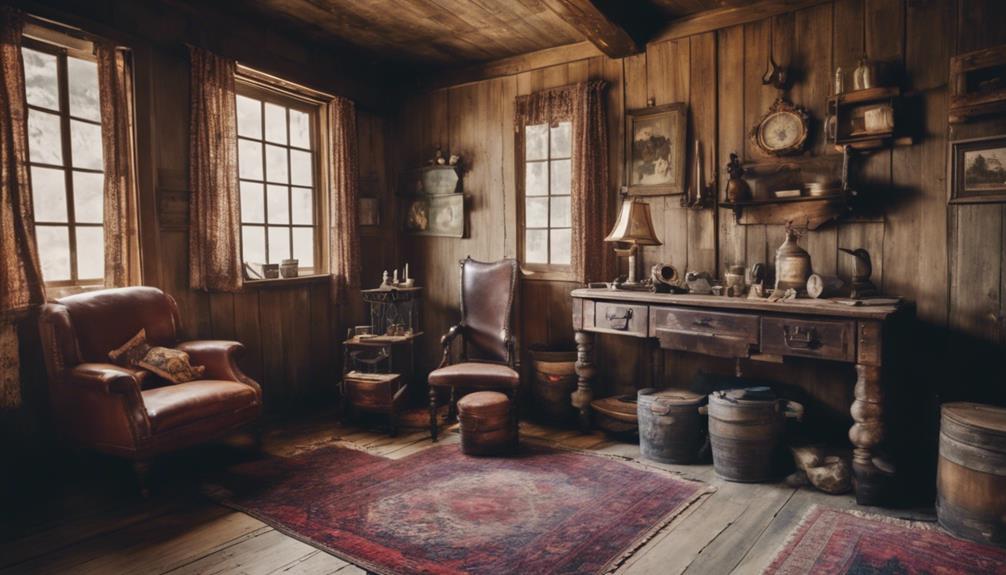
When it comes to flooring in your country decor, you've got some fantastic options.
Reclaimed barn wood flooring brings a rustic charm, while distressed painted hardwood planks add a splash of character.
Don't forget about antique tile mosaics, which can create a stunning focal point and enhance the overall aesthetic of your space.
Reclaimed Barn Wood Flooring
Reclaimed barn wood flooring brings a unique rustic charm to your country decor, showcasing its rich history and natural patina. Sourced from old barns, this flooring offers a distinct character that you won't find in new wood options. Each plank tells a story, adding depth to your space while enhancing its aesthetic appeal.
Not only is reclaimed barn wood beautiful, but it's also a sustainable choice. By repurposing materials that would otherwise go to waste, you're reducing your environmental impact. Plus, its durability and strength make it ideal for high-traffic areas in your home. The dense grain patterns guarantee that it stands up to everyday wear and tear.
The warm tones and textures of reclaimed barn wood can seamlessly complement various design styles, from traditional country to modern farmhouse. And don't forget the cost-effectiveness; reclaimed barn wood often comes at a lower price point than new hardwood flooring, making it a budget-friendly choice that adds character and charm to any room.
Embrace the unique appeal of reclaimed barn wood flooring and transform your country decor into a warm, inviting space.
Distressed Painted Hardwood Planks
Distressed painted hardwood planks bring a unique blend of rustic charm and practicality to your country decor, making them an excellent flooring option that beautifully complements vintage and antique furnishings.
These distressed planks not only add character to your space but also hide wear and tear, making them a good choice for high-traffic areas in your home.
You'll find distressed painted hardwood planks available in various colors, allowing you to customize them to match your room's overall color palette. This flexibility enhances the cohesive aesthetic of your country decor.
Often sourced from reclaimed wood, these planks promote sustainability while providing a unique history to each piece, resonating perfectly with the vintage ethos of country style.
Additionally, the texture of distressed hardwood planks contributes to a warm, inviting atmosphere, making your home feel cozy and welcoming.
Whether you're updating your living room or kitchen, these planks serve as a functional yet stylish foundation, connecting your antique furnishings with a timeless, rustic appeal.
Choosing distressed painted hardwood planks is a practical way to enhance your country decor while embracing sustainability and history.
Antique Tile Mosaic Flooring
Antique tile mosaic flooring frequently transforms country decor by adding an artistic flair through its intricate patterns and historical designs. When you choose this flooring, you're not just selecting a surface; you're incorporating a piece of history that enhances your home's character. Made from durable materials like ceramic or terracotta, these tiles stand up to the demands of busy households while retaining their beauty.
Using reclaimed antique tiles promotes sustainability and further enriches the rustic charm of your country-style interiors. You can mix and match colors, shapes, and sizes to create a personalized design that speaks to your individual style and complements the surrounding landscape.
However, keep in mind that installing antique tile mosaic flooring requires careful planning and skilled craftsmanship. This investment not only elevates your home's aesthetic but also assures you of a long-lasting foundation.
The unique appeal of these tiles will draw attention, inviting guests to admire the artistry beneath their feet. So, consider antique tile mosaic flooring as a stunning and functional addition to your country decor that marries history with contemporary living beautifully.
Conclusion
Incorporating antiques into your country decor can truly elevate your space, adding character and warmth. When looking for antiques to complement your country decor, consider adding vintage furniture ideas such as a distressed farmhouse dining table or a weathered wooden chest. These pieces can add a sense of history and charm to your home, creating a cozy and inviting atmosphere. Whether it’s a worn leather armchair or a retro lamp, incorporating antiques into your country decor can help create a unique and timeless look for your space.
By focusing on key elements, essential fixtures, and unique lighting, you can create a cozy atmosphere that reflects your style.
Don't forget to choose decorative items that complement your theme and consider the flooring to tie everything together.
Embrace the charm of vintage pieces, and you'll transform your home into a welcoming retreat that tells a story all its own.

